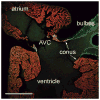Phylogeny informs ontogeny: a proposed common theme in the arterial pole of the vertebrate heart
- PMID: 21040422
- PMCID: PMC4180519
- DOI: 10.1111/j.1525-142X.2010.00441.x
Phylogeny informs ontogeny: a proposed common theme in the arterial pole of the vertebrate heart
Abstract
In chick and mouse embryogenesis, a population of cells described as the secondary heart field (SHF) adds both myocardium and smooth muscle to the developing cardiac outflow tract (OFT). Following this addition, at approximately HH stage 22 in chick embryos, for example, the SHF can be identified architecturally by an overlapping seam at the arterial pole, where beating myocardium forms a junction with the smooth muscle of the arterial system. Previously, using either immunohistochemistry or nitric oxide indicators such as diaminofluorescein 2-diacetate, we have shown that a similar overlapping architecture also exists in the arterial pole of zebrafish and some shark species. However, although recent work suggests that development of the zebrafish OFT may also proceed by addition of a SHF-like population of cells, the presence of a true SHF in zebrafish and in many other developmental biological models remains an open question. We performed a comprehensive morphological study of the OFT of a wide range of vertebrates. Our data suggest that all vertebrates possess three fundamental OFT components: a proximal myocardial component, a distal smooth muscle component, and a middle component that contains overlapping myocardium and smooth muscle surrounding and supporting the outflow valves. Because the middle OFT component of avians and mammals is derived from the SHF, our observations suggest that a SHF may be an evolutionarily conserved theme in vertebrate embryogenesis.
© 2010 Wiley Periodicals, Inc.
Figures










Similar articles
-
Ablation of the secondary heart field leads to tetralogy of Fallot and pulmonary atresia.Dev Biol. 2005 Aug 1;284(1):72-83. doi: 10.1016/j.ydbio.2005.05.003. Dev Biol. 2005. PMID: 15950213
-
Secondary heart field contributes myocardium and smooth muscle to the arterial pole of the developing heart.Dev Biol. 2005 May 1;281(1):78-90. doi: 10.1016/j.ydbio.2005.02.012. Dev Biol. 2005. PMID: 15848390
-
Cardiac neural crest is necessary for normal addition of the myocardium to the arterial pole from the secondary heart field.Dev Biol. 2005 May 1;281(1):66-77. doi: 10.1016/j.ydbio.2005.02.011. Dev Biol. 2005. PMID: 15848389
-
How to make a heart: the origin and regulation of cardiac progenitor cells.Curr Top Dev Biol. 2010;90:1-41. doi: 10.1016/S0070-2153(10)90001-X. Curr Top Dev Biol. 2010. PMID: 20691846 Review.
-
Vertebrate heart development.Curr Opin Genet Dev. 1996 Aug;6(4):454-60. doi: 10.1016/s0959-437x(96)80067-0. Curr Opin Genet Dev. 1996. PMID: 8791539 Review.
Cited by
-
Latent TGFβ-binding proteins 1 and 3 protect the larval zebrafish outflow tract from aneurysmal dilatation.Dis Model Mech. 2022 Mar 1;15(3):dmm046979. doi: 10.1242/dmm.046979. Epub 2022 Mar 28. Dis Model Mech. 2022. PMID: 35098309 Free PMC article.
-
Structure and vascularization of the ventricular myocardium in Holocephali: their evolutionary significance.J Anat. 2015 Jun;226(6):501-10. doi: 10.1111/joa.12317. J Anat. 2015. PMID: 25994124 Free PMC article.
-
Development of the hearts of lizards and snakes and perspectives to cardiac evolution.PLoS One. 2013 Jun 5;8(6):e63651. doi: 10.1371/journal.pone.0063651. Print 2013. PLoS One. 2013. PMID: 23755108 Free PMC article.
-
The avian embryo as a time-honoured animal model in developmental, biomedical and agricultural research.Philos Trans R Soc Lond B Biol Sci. 2025 Feb 27;380(1920):20230438. doi: 10.1098/rstb.2023.0438. Epub 2025 Feb 27. Philos Trans R Soc Lond B Biol Sci. 2025. PMID: 40010394 Review.
-
The zebrafish model system in cardiovascular research: A tiny fish with mighty prospects.Glob Cardiol Sci Pract. 2013 Nov 1;2013(1):9-28. doi: 10.5339/gcsp.2013.4. eCollection 2013. Glob Cardiol Sci Pract. 2013. PMID: 24688998 Free PMC article. Review. No abstract available.
References
-
- Abu-Issa R, Kirby ML. Heart field: from Mesoderm to heart tube. Annu Rev Cell Dev Biol. 2007;23:45–68. - PubMed
-
- Anderson RH, Wilkinson JL, Becker AE. The bulbus cordis—a misunderstood region of the developing human heart: its significance to the classification of congenital cardiac malformations. Birth Defects Orig Artic Ser. 1978;14:1–28. - PubMed
-
- Bartelings MM, Gittenberger-de Groot AC. The outflow tract of the heart - embryologic and morphologic correlations. Int J Cardiol. 1989;22:289–300. - PubMed
-
- Blitz IL, Andelfinger G, Horb ME. Germ layers to organs: using Xenopus to study “later” development. Semin Cell Dev Biol. 2006;17:133–145. - PubMed
Publication types
MeSH terms
Grants and funding
LinkOut - more resources
Full Text Sources
Molecular Biology Databases

